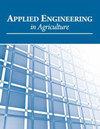天气监测网中的站点干旱:来自俄克拉荷马州Mesonet的证据
IF 0.8
4区 农林科学
Q4 AGRICULTURAL ENGINEERING
引用次数: 1
摘要
灌溉区天气监测网络的站点干旱会导致对土壤水分的高估。在一个中尺度天气监测网中演示了站内的干旱情况。在干旱期间,缺水的灌溉区的车站干旱加剧。通过气象信息灌溉实现节水,应考虑站内干旱情况。许多天气监测网络,如俄克拉何马Mesonet,提供参考蒸散量(ETref)的估计值,以促进根据天气情况作出灌溉决策。然而,使用广泛应用的ASCE标准化ettref方程收集所需输入数据以估计ettref的气象站通常不会安装在参考表面上,参考表面定义为具有指定高度,表面阻力和反照率的大片密集,水分充足,无应力的草或苜蓿。气象站周围环境的实际地面条件与参考条件的偏差会产生站内干旱效应,从而导致ettref的高估。利用2000-2019年20年的日水文气候数据集,评估了俄克拉何马Mesonet站点干旱的普遍性和时空特征。利用平均露点偏差(MDD = Tmin - Tdew)、最大相对湿度(RHmax)和归一化植被指数(NDVI)对站点干旱进行表征。结果表明,随着俄克拉何马州狭长地带从东南到西北的增加,干旱在俄克拉何马Mesonet地区普遍存在,并且在空间和时间上都有很大的变化。2011年俄克拉何马州西部(该州大部分灌溉农业(88%)所在地)的极端至异常干旱期间,观察到较大的平均季节性MDD(高达13°C),较低的RHmax(例如57%)和较低的NDVI(例如0.22)。站内干旱的时空格局显示了干湿期的深远影响,影响了ettref估算在缺水灌区高灌溉需求时期改善农业节水的效用。关键词:蒸散发,需水量,参考条件,站点干旱,气象站。本文章由计算机程序翻译,如有差异,请以英文原文为准。
Station Aridity in Weather Monitoring Networks: Evidence from the Oklahoma Mesonet
HighlightsStation aridity can cause overestimation of ETref at weather monitoring networks in irrigated areas.Station aridity was demonstrated in a mesoscale weather monitoring network.Station aridity is amplified in water-scarce irrigated areas during droughts.Station aridity should be accounted for to achieve water conservation through weather-informed irrigation.Abstract. Many weather monitoring networks such as the Oklahoma Mesonet provide estimates of reference evapotranspiration (ETref) to facilitate weather-informed irrigation decisions. However, weather stations that collect the required input data to estimate ETref using the widely applied ASCE standardized ETref equation are not typically installed over a reference surface, defined as a large expanse of dense, well-watered, stress-free grass or alfalfa having a specified height, surface resistance, and albedo. The deviation of actual surface conditions in the surrounding environment of the weather stations from the reference condition creates station aridity effects that can lead to overestimation of ETref. Daily hydroclimate datasets for a period of 20 years (2000-2019) were used to evaluate the prevalence and spatiotemporal characteristics of station aridity across the Oklahoma Mesonet. Station aridity was characterized based on mean dew point deviation (MDD = Tmin - Tdew), maximum relative humidity (RHmax), and normalized difference vegetation index (NDVI). Results demonstrate that station aridity is prevalent and highly variable in both space and time across the Oklahoma Mesonet, as it increases from southeast to northwest in the Oklahoma Panhandle. Larger average seasonal MDD (up to 13°C), lower RHmax (e.g., 57%), and lower NDVI (e.g., 0.22) were observed during extreme to exceptional drought of 2011 in western Oklahoma, where a majority of the state’s irrigated agriculture (88%) is located. Spatiotemporal patterns of station aridity demonstrate the profound effect of wet and dry periods that influence the utility of ETref estimates to improve agricultural water conservation during high irrigation requirement times in water-scarce irrigated areas. Keywords: Evapotranspiration, Irrigation requirement, Reference condition, Station aridity, Weather station.
求助全文
通过发布文献求助,成功后即可免费获取论文全文。
去求助
来源期刊

Applied Engineering in Agriculture
农林科学-农业工程
CiteScore
1.80
自引率
11.10%
发文量
69
审稿时长
6 months
期刊介绍:
This peer-reviewed journal publishes applications of engineering and technology research that address agricultural, food, and biological systems problems. Submissions must include results of practical experiences, tests, or trials presented in a manner and style that will allow easy adaptation by others; results of reviews or studies of installations or applications with substantially new or significant information not readily available in other refereed publications; or a description of successful methods of techniques of education, outreach, or technology transfer.
 求助内容:
求助内容: 应助结果提醒方式:
应助结果提醒方式:


